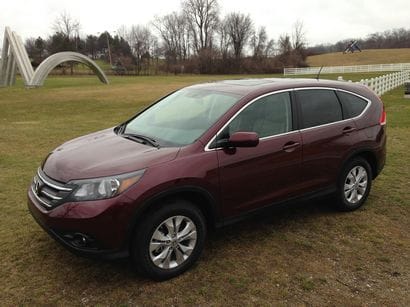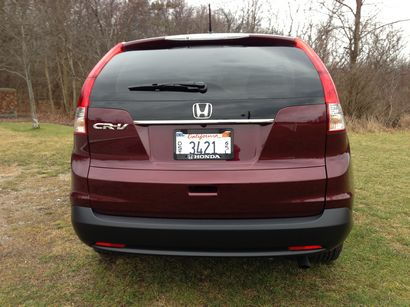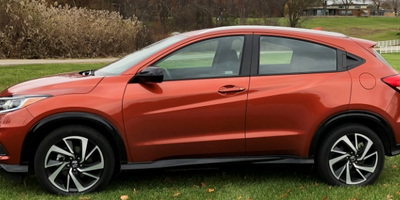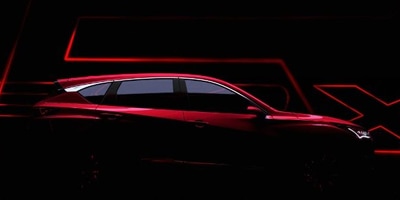We spend a week in the compact crossover SUV from Honda
Pros:
Smooth engine and transmission
Visibility
Fit and finish, ergonomics, switchgear
Cons:
Road noise
Electric steering setup could use more on-center feel
The 2013 CR-V
Honda has been building what is currently its smallest crossover SUV, based on the Civic platform, since the 1995 model year and it has been manufactured here in North America since 2007. Depending on who you speak with, CR-V either stands for "Compact Recreational Vehicle or "Comfortable Runabout Vehicle."
But no matter which you think it might be, the fact is that the CR-V is the best-selling vehicle in the segment. In 2012 alone it outsold its nearest competitor, the Ford Escape, by some 20,500-odd units. In December, alone, the newly-resurgent Honda topped its competitor from Dearborn by 5,600 vehicles.
So you can see why, when it came time to redesign the CR-V in 2012, that it was critical for the engineers and stylists at Honda to get it right. For the most part, they did.

2013 Honda CR-V
Honda started by retaining the model's all-aluminum 2.4-liter i-VTEC 4-cylinder engine paired to a somewhat less than cutting-edge 5-speed automatic. For the fourth generation model, horsepower has been upped from 180 to 185, while torque was also bumped from 161 to 163 lb.-ft.
Despite the increase in horsepower and torque, the CRV's fuel economy numbers have improved. EPA-estimated fuel economy for front-wheel-drive versions is now rated at 23/31/26 city/highway/combined mpg – an increase of +2+3+2, respectively, over the previous generation. All-wheel-drive variants are now rated at 22/30/25 city/highway/combined mpg – an increase of +1/+3/+2, respectively, again an improvement over the old model.

Fuel economy numbers are also aided by a new Eco Assist function that features two crescent-shaped ambient light bars that flank either side of the speedometer. In practice they gradually morph from white to green as a reward for efficient driving, while a selectable ECON mode does its job by altering the vehicle's operating characteristics to further enhance fuel economy.
Honda then set about making the CR-V's packaging even more efficient. Versus the outgoing model, the new one is one inch shorter and nearly an inch and a half lower. Its wheelbase and width remain unchanged, while ground clearance is less by four tenths of an inch and front and rear tracks up by just one tenth of an inch each.
Despite these reductions, Honda has managed to increase the cargo capacity behind the rear seat from 35.7 to 37.2 cubic feet. The rear liftover height, with the tailgate open, has also been reduced from 27.1 to 26.1 inches.

Exterior
Outside, despite the fact that the styling and shape will be familiar to all, the fourth generation CR-V shares nothing with its predecessor. It not only looks sleeker, it actually is, with an eight percent drag coefficient improvement.
Up front, the CR-V features its own interpretation of Honda's bolder-looking three-bar front grille and deeply-set multi-reflector headlights. Along the sides, there is deeper sculpting of the body lines, while the signature vertical rear taillights are now more three-dimensional as they wrap around the rear quarter panels.

Design elements that include a longer roofline and integrated rear spoiler also add to the crossover's improved aerodynamic efficiency.

Interior
Inside, Honda has added refinements to what was already a class-leading interior. By pushing the windshield forward and adding additional sound insulation, noise levels have been reduced.
The new CR-V also features a larger center console with sliding lid with enough storage area inside for a handbag. It also hides standard USB and auxiliary ports as well as a 12 volt power outlet. And while the console houses the requisite two cup holders, it also has under storage areas on either side large enough to accommodate a standard water bottle.

New standard technologies available on all models come in the form of iPhone supported Pandora Internet Radio as well as SMS text reading and response for supported Blackberry devices via a new standard five-inch color multi-information display.
Other new added standard features include a wide-view rear camera, Bluetooth connectivity and a one-touch fold-down rear seat with the release levers located on either side of the rear storage area. My only quibble with the interior had to do with the upper door trim – the plastic found in these areas was fairly hard, where other manufacturers are now emphasizing soft-touch trim.
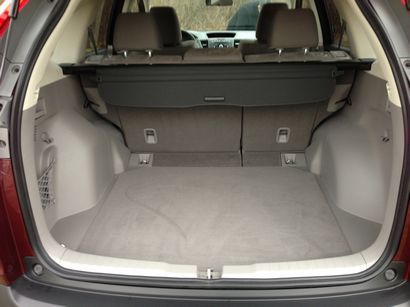
Instruments are clear and easy to read, while the typically smooth console and center-stack buttons and controls are, for the most part, easy to interpret. The only issue I had with this setup involves the large round knob that controls most of the on-screen functions of the infotainment system. It could use a little work, as some of the duties it's required to perform don't come naturally and could be more intuitive. That being said, it did take me less than a minute to pair my iPhone to it.
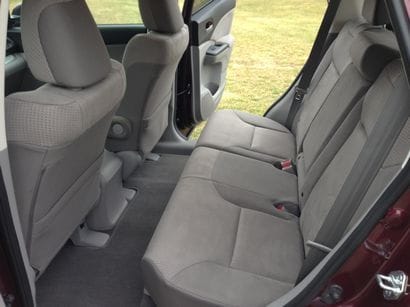
Front seat passengers have a generous amount of head, shoulder and leg room. In back, up to three rear-seat passengers will find a flat floor, along with plenty of room, featuring high-sitting and well-shaped seats along with easy ingress and egress.
Loading objects into the cargo area is also a snap while folding the 60/40 split rear seats, even from the larger rear hatch opening, is also easy via the two remote release levers located on either side of the storage area just forward of the hatch opening.
Cargo volume behind the rear seat is a generous 37.2 cubic feet. With both rear seats flipped forward, that expands to 70.9 cubic feet.
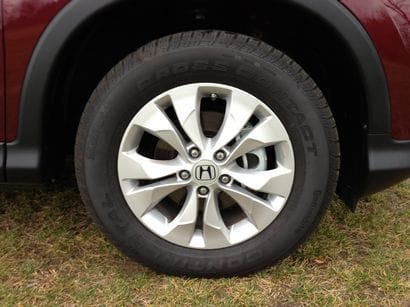
On the road
By their very definition, crossover SUV's are not the type of vehicles you normally associate with either twisty roads or straight-line performance. This is also the case with the 2013 CR-V.
On the road, the new CR-V feels solid and well-planted. Despite some heavy cross-winds, it never felt skittish, even at freeway speeds. Tossing it into a corner elicited absolutely no drama and minimal body lean. Noise level is also down from that of the previous generation, although rougher surfaces can bring through a noticeable amount of tire noise.

The inline-four, while both smoother and more powerful, has a tendency to become very un-Honda-like when you put your foot into it with some raucous noises emanating from under the hood in passing maneuvers and under heavy acceleration. Braking, on the other hand, is and it's easy to modulate the brake pedal.
As for its steering, for the most part it's very good. Feedback through the steering wheel is decent and the weight builds nicely – communicating exactly where you are on the road - with the exception of a little on-center deadness which is something I've learned to live with regarding the majority of electrically-assisted systems.

Speaking of steering systems, the CR-V comes equipped with Honda's Motion-Adaptive Electric Power Steering (EPS). Working in conjunction with the vehicle's standard stability control it works to detect instability in slippery road conditions during cornering as well as under braking and automatically initiates steering inputs that prompt the driver to steer in the correct direction.

Equipment and pricing
Like all Hondas, the CRV's new car pricing structure is fairly simple. Eschewing traditional options packages – there are none – the company's smallest SUV is available in a total of flavors. It begins with three trim levels – LX, EX and EX-L. Both the LX and EX are available in front-wheel or all-wheel-drive configurations.
The top-line front-wheel and all-wheel-drive EX-L models are available in three trim levels, each: standard, with a rear entertainment system or with a navigation system.

All CR-V's come with power windows, seats and mirrors, rearview camera, Bluetooth HandsFreeLink, steering wheel-mounted cruise, audio, phone and infotainment controls (Honda's i-MID system), keyless entry and a 4-speaker audio system including CD player.
Stepping up to the EX adds a more powerful 6-speaker audio system along with a moonroof, rear privacy glass, fog lights and a security system.
EX-L buyers also get dual-zone automatic climate control, a leather-wrapped steering wheel and leather seats (heated in front), power driver's seat with power lumbar adjustment, a 328-watt 7 speaker audio system that includes a subwoofer and XM radio and standard exterior roof rails.

EX-L owners can also opt for the aforementioned rear DVD entertainment system or a satellite-linked navigation system, but not both.
Retail pricing, including an $830 destination and handling charge, begins at $23,625 for a front-wheel drive LX model and tops out at $31,125 for an EX-L model with navigation. Our two-wheel-drive EX our model that featured a Basque Red exterior and gray cloth interior came with an MSRP, including destination and handling, of $25,625.
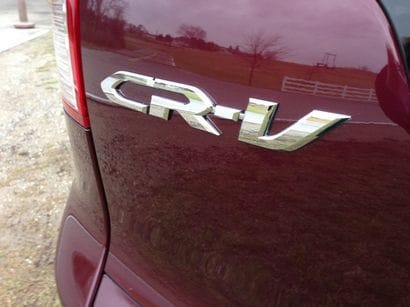
The Bottom Line
For 2013, Honda's newest CR-V has a lot going for it – attractive styling, improved fuel economy, a quieter, although hardly segment-leading, ride and a comfortable, nicely-appointed (except for the upper door trim) interior. Given these qualities, its latest "Comfortable Runabout Vehicle" should help Honda maintain its leadership role in the segment.


